Fourth-generation Kutch weaver Vankar Rajan Bhimji shares the craft wisdom of this unique textile tradition.
Historical origins of my folk art
The weavers of Kutch claim a 500-year-old history in the region. They are originally from Rajasthan. There are two stories of their migration. One story goes that when a girl of a very rich Rabari family was given in marriage and come to Kutch, a weaver was included as part of her dowry so that he could weave the clothes that she would need. This family of weavers gradually grew into a larger community and spread in different settlements of Kutch.
As per the second story, our lord Shri Ramdev peer came to Narayan Sarovar in Kutch on a pilgrimage from Rajasthan. At the time, some followers who were goldsmiths of faradi in mandvi built a temple for him and requested him to bring his kin from Marwar in Rajasthan for its upkeep. That was the beginning of the settlement of the Meghwal community of weavers from Marwar. This Meghwal community was of four sub-castes: Maheshwari, Marwada, Gurjara and Chaaran. Of these the Maheshwari and marwada sub castes practiced weaving and leatherwork.
Thus the Meghwal community of Rajasthan migrated from Kutch, bringing with them the art of handloom weaving. Traditionally, weavers used handspun yarn provided by Rabaris, a nomadic community of sheep and goat herders. Weaving was a local art which provided Kutch communities with blankets, cloth, and traditional dress. Kutch weaving is known for its incorporation of distinctive traditional motifs and colours in medium to heavyweight textiles. The value of Kutch handlooms exceeds aesthetic appeal. Its value is created by the hands of skilled artisans who weave their tradition and way of life into each piece.
Shawls are woven with motifs, which have been passed down through generations of artisan communities. They were originally made from local des wools and were traditionally worn as veils. The shawl featured here incorporates the traditional dhulki motif. Artisans continue to design and produce shawls for the local market as their shawls are widely worn throughout Kutch in the winter months. Over the years, the weavers spread out in large clusters and smaller pockets throughout Kutch.
Our family heritage
I am preserving my ancestor’s centuries-old traditional art called “Traditional Kutch weaving”. My ancestors say our family is doing for the past 150 years, but it’s a 600 years-old tradition. In ancient India, the work system was distributed as per the different communities. Our community was specialized in weaving clothes. Then we started weaving dhablas, and then shawls, stoles, scarves, fabric. Saree’s came into existence slowly and gradually. Now, all shawls and stoles are commonly used by many people to survive the cold winters and as a fashion statement. In the current decade, peoples of different parts of the world are using my traditional art for historical art heritage.
600 years ago, (my forefathers) the marwada community from Rajasthan, migrated to the Kutch and are known today for the art of Traditional Kutch weaving in Gujarat. Traditionally, weavers used hand-spun cotton yarn provided by the ahir and patel farming communities and the wool provided by the rabari and jat pastoral communities. Weaving was a local art, which provided the Kutch communities with blankets, cloth, and traditional dress. Today it is a continuing vibrant tradition that is consumed by both local communities and people around the country and the world.
Materials
Pure fine merino wool
Raw pure fine merino wool comes from Australia and New Zealand. Merino wool goes to Ludhiana city of Punjab, India for spinning in mills. Our family purchased pure fine merino wool from spinning mills of Ludhiana from last 35 years. Today we are using finest and thinnest merino wool (thread count 2/80. 2/72,2/92 etc), which are luxuriously soft and light in weight.
Tussar silk
Tussar silk is valued for its rich texture and natural deep gold colour. Varieties are produced in many countries, including China, India, Japan, and Sri Lanka. Tussar Silk, also often referred to as ‘Wild Silk, is an exquisite thread obtained from a wide-winged moth that is yellowish-brown in colour. The scientific name of these moths is Antheraea Paphia and they are a part of the group known as Emperor Moths or Saturnids. These moths are a true wonder of nature. Their wings are embellished by circular markings that look like a mirror. Indeed, when you look closely into those circular markings, you’ll be able to see a reflection of yourself. India is the second-largest producer of tussar silk. much of it is produced in Bhagalpur of Bihar and Bhagaiya of Jharkhand. Our tussar silk comes from Bhagaiya.
Our old natural handspun desi sheep wool
Desi hand-spun wool is our local wool source from Rabaris (indigenous tribal caste). Local desi wool is hand spun by my grandmother and some older rabari women’s. Hand spinning local desi wool requires high skills, a deep sense of hand spinning and experience how to spin a yarn and make thread to wind onto charkha. Local desi wool is too warm in cold winters.
Organic kala cotton
Kala cotton is indigenous to Kutch and organic, as the farmers do not use any pesticides and synthetic fertilizers. It is a purely rain-fed crop that has a high tolerance for both disease and pests, and requires minimal investment. It is resilient and resurgent in the face of difficult land conditions. It forms a strong, coarse, stretchable fibre that is often used in denim. As it is difficult to produce fine quality textiles with it, as its short staple length translates to fewer twists per inch of yarn, over time its use has diminished significantly in mainstream markets. I am focusing on and experimenting on kala cotton with perfect natural vegetable dyeing, including natural vegetable colours such as indigo, black, grey-beige, red, peach, green (made with indigo), and many earth colours.
Tools
Killori is a brush made for combing the warp it is set. The bristles made from a plant which grows in Rann (desert). The plant is picked and then placed in water and boiled for two days. It is combed and placed in oil for one day until it becomes smooth. it lasts quite long, which is around 10 to 15 years.
The warp stand is used to support the warp when it is in the process of being set. Now we also use a metallic stand. Earlier they were crude, wooden and made out of dry branches of nearby trees.
Different reeds or Phani are used for kinds of wool. The number of dents decides the quality of fabric produced. acrylic reeds are used for merino wool or desi wool.
The shuttle box is a wooden box placed on each of the two ends of sley. Its function is to provide a place of momentary rest for the shuttle as it races from one end to the other with the blow of the picker.
The shuttle is made of wood, has round sides and tappers to a point. The thread emerges an eye on side of the shuttle.
The shuttle picker is a device that picks the shuttle when it is thrust forward from one side of the loom to the other, putting the weft inside the warp hence weaving the cloth. It is a strap of leather fixed in each of the shuttle boxes. The picker has two holes and a cord attached to it, the cord being connected to the picking cord, which in turn in tied to the top of sley. A pull at the picking cord makes the shuttle fly from one shuttle box to the other.
The size of the frame depends on the size of the sley and beams. grooves are provided on both sidebars of the frame so as made up of wood and is kept in position with a wooden batten fixed on its and bottom.
There is one beam that is fixed in front of the weaver’s seat. It is known as ”tor” and Is the cloth rolling beam. Seasoned wood is used for making these beams. It is rectangular in shape. The length of the beam is generally equal to the width of the frame. Towards the right-hand side of the cloth beam, there are four holes in each of the rectangular surfaces, which travel to the other side of the beam. The cloth beam has in one surface to groove, which has a series of iron nails that hold an iron rod in place. This iron rod is inserted through the warp of the cloth, which then is secured to the beam through attachment.
The top bar sley top rest is a wooden beam fixed horizontally on top of the sley. It holds the sidebar in position. It is parallel to the sley and the entire body of the sley is suspended by two iron pins projecting from the ends of the top bar. IT is inserted through a gap in the wooden frame.
The sley is a shuttle race board with a shuttle box is provided in each end. There is also an arrangement for reed and keeping warp ends in the proper position. A little pull to the sley is made wood. The size of the sley depends upon the width of the cloth to be woven and therefore there are different sleys for different width sizes.
Panakh is also known as the temple. This keeps the width of woven cloth constant. It is made of wood. and has been smoothened to avoid snags in the cloth. At both ends of ”panakh”, there are steel caps, which have a pointed end, which is inserted into the selvedge of the cloth. This counteracts the shrinkage of the cloth due to pull of weft during weaving and also maintains the breathe wise tension of fabric.
Khunto (pile), also known as ”Ganesh”, is one of the main parts of the loom and every day aarti (prayer) is performed. Ganesh makes the warp go forward.
Tor: after loosening the warp, the stick is inserted into the following hole and then is pulled backwards and thus tightened.
The Charkha is also known as “Sancho” and spinning wheel. The charkha, a small, portable, hand-cranked wheel, is ideal for spinning cotton and other fine, short-staple fibres, though it can be used to spin other fibres as well. The size varies, from that of a hardbound novel to the size of a briefcase, to a floor charkha. Charkha is an Indian type of spinning wheel. Also, our great Mahatma Gandhi ji spun a khadi yarn on charkha in the late eighteenth and early nineteenth century.
The loom has many components that work in hand to hand with the weaver to produce a shawls, stole, fabric with ease.
Technique/Process
Warping
The Sheep wool shearing is done usually after the rains. They shear the wool twice during the summer. The shorn wool goes to barmer and gets spun there and at times get they get ready-made spun wool from there. The wool is then made into a warp taking it around warping page, which is fixed on to a wooden frame, which is placed vertically while making a warp. The warp yarn is wound around a wooden frame getting looped around wooden pegs at a length of 55-60m. Out of these 20 – 25 shawls are woven. This warp is then stretched out and its coated with starch. The warp is supported by JAAL on an empty stretch of land between the houses.
Set up for warping
The warping process is generally carried out by women. Leases are inserted alternatively so that the yarns don’t get entangled. The leases are either wooden or metal. The wooden leases are branches from nearby trees, which are broken when still green, and are burnt for durability, smoothness and hardness. The wool is wet and is then stretched and each strand is doubled to save time when warping. After the starch is applied, they comb the warp with a kilori. While drying, they separate the warp is also by hand. When dried, they remove the lease rods, and taking thread, they tie the warp lengthwise so it is easier to roll. The shafts are made in the beginning, when the first warp is made, the threads, which are nylon cords, are tied around the threads of the warp manually. That is how the shafts are created. It is time-consuming as the warp comprises of more than a thousand threads. When the warping is done, around one foot is left so that new warp can be joined. ‘Rakh’ is put on fingers so that when rolling the yarns together, it is done easily.
The starching process
Next day warping yarn is prepared for starching. This involves soaking it in a preparation of wheat flour and wild onions. The wild onions are boiled for 24 hours, mashed into a paste, then cold water is poured, and wheat flour mixed. The yarn is soaked in this solution and dried in the early hours of the morning. The time is specific to avoid letting the yarn become brittle. The wild onion process is special: it makes the wool stronger and acts as a deterrent in any insects giving the product a longer life. Starched is required with the desi comb called “Kilori”. After the starched is applied, they comb the warp starch with Kilori. While drying, they separate the warp also by hand. When dried they remove the lease rods, and taking thread, they tie the warp lengthwise so it is easier to roll. This is our traditional methods, process, technique for warping and starching process which I learnt from my father and mother.
Sizing (wild onion process)
The sizing process takes longer for the handspun desi wool warp than the other pure fine merino wool, or cotton, silk etc warp. Being very weak, the wool Is sized in three days in continuation. The first day, it is sized with plain water and dried. On the second day, it is sized with maida starch and dried. And on the third day, it is sized with verath (wild onions) starch and then dried.
Starching is usually done with rice water solution. Desi wool is starched with a mix of wheat flour and wild onions. The wild onion treatment makes the wool stronger and acts as a deterrent to insects giving the product a longer life. Verath (wild onions) is a bulb-like onion, white in a colour which grows in the nearby mountains during monsoons. The weavers go and collect it, dry it, and store it in gunny sacks for the whole year. Theyboil it, mash it and dip the wool in it, using it as starch when the warp is prepared. Berath is bitter and hence it keeps the wool safe from being eaten by insects.
Sandhni (Yarn jointing on loom)
The warp is wound onto a kana (wooden lease rod) and is kept till the warp is over so that it can be joined. The reed is 25 inches wide. The panakh is made of kana, it becomes smooth due to the presence of flour during warping. Warping is done after every 8 to 10 days. The selvedge is double the number of threads. The process is called sandhni, then the warp is ready for weaving.
Bobbin making
The bobbin winder is used to convert bigger hanks into smaller ones and then converting them into bobbins. Chad or shed sword is a strip wood about 2 inch to 3 inch wide and tapers to a point the formed beneath the picked up yarns are usually held open with shed swords turned sidewise in the warp. Treadles are rectangular wooden block, most of the time, four in number, which are connected to the harnesses and pressing them lifts the shafts. This makes smaller bobbins. Bobbins are used to wind yarn around them. They are then inserted in the shuttle and the yarn is taken out from the shuttle through an eyelet.
Weaving
The shawls in Kutch are woven in plain weave with extra weft ornamentation. It has one ground pick and one extra weft pick for the motif or the borders. The loom is used throw shuttle or a flying shuttle pi loom. Nowadays, frame looms are used. The number of shafts used is usually four.
Drafting
The purpose of this process Is to keep parallel to one another and to divide them into the sheds while weaving is done. the drafting is done once when the new warp is woven. The later shawls just add on to the exiting ends of the last warp if the same colour and configuration required.
Denting
This is a process of drawing warp ends through the dents of a reed. The denting is done two ends per dent where ends from 1st and 3rd shaft and 4th shaft are dented together.
- lifting order of the shafts – plain 3/24
- pedal order – extra weft 12/34
- plain – 12/34
- extra weft – 13/24
The art of weaving is governed by three primary motions: the shedding motion, the picking motion, the beating motion.
Shedding motion
The shedding motion consists in depressing the treadle by one foot, which results in making an opening in the warp threads. the opening or the tunnels is known as a shed. shedding for extra weft is done at time by lifting up chad stick, which picks up threads in a fashion so as to create a pattern after being woven.
Picking and beating motion
The insertion of weft through the shed is called picking. It consists of propelling the shuttle by tugging at the rope connected to the shuttle picker. This results in a push to the shuttle in the shuttle box and lets it run across the opening on the other side. During extra weft insertion, the picking is done by hand. At times a lot of handwork done because the entire body of the shawl may be ornamented with patterns.
The beating motion consists of carrying forward of the last inserted pick of weft to cloth already woven. Beating up the weft threads happens by drawing the sley forward. The picking and beating operations are fixed independent of the type of fabric produced, but the shedding motion is variable and can be described as the heart of weaving as it is here that the nature of the interlacing, or the weave is decided.
Finishing
Shawls edges are finished by attaching colourful tassels to them. They are then washed, cleaned and ironed to remove starch, which was added earlier and is then stocked or sent to the client.
The process of weaving and warping is shared both by men and women. The women, apart from her household chores, wind the yarn into bobbins and help with the starching. When the warp is ready for weaving, the men take over. The old warp is joined to the new, which eliminates time for setting up the whole warp.
Author
 Vankar Rajan Bhimji is a fourth-generation artisan that belongs to a traditional weaving family of Sarli village in Kutch region. Vankar Rajan Bhimjiand his family have been creating radiant and earth coloured, intricately woven textiles for six generations. Rajan grew up watching his father and great grandfather in his family workshop and learnt their traditional weaving art. He went in an exhibition with his father for the first time when he was nine years old. Working with designers in international arena for years, Rajan understood the modern contemporary designs with today’s fashion. He has kept those all modern design thoughts in mind and expressed contemporary designs in traditional weaving technique of his family. Rajan uses natural vegetable dye and other free dyes to make luxuriously gorgeous colors for woven textiles of which is identity of his Kutch region. Significant motifs of his woven textiles ,such as chomukh, dhunglo represent mountains and dhulki, landhar embody snake slithering. Moreover, sachi vaat means true way of life, its geometric patterns and inspired from nature motifs. You can contain Rajan by email or mobile +91 9537348821.
Vankar Rajan Bhimji is a fourth-generation artisan that belongs to a traditional weaving family of Sarli village in Kutch region. Vankar Rajan Bhimjiand his family have been creating radiant and earth coloured, intricately woven textiles for six generations. Rajan grew up watching his father and great grandfather in his family workshop and learnt their traditional weaving art. He went in an exhibition with his father for the first time when he was nine years old. Working with designers in international arena for years, Rajan understood the modern contemporary designs with today’s fashion. He has kept those all modern design thoughts in mind and expressed contemporary designs in traditional weaving technique of his family. Rajan uses natural vegetable dye and other free dyes to make luxuriously gorgeous colors for woven textiles of which is identity of his Kutch region. Significant motifs of his woven textiles ,such as chomukh, dhunglo represent mountains and dhulki, landhar embody snake slithering. Moreover, sachi vaat means true way of life, its geometric patterns and inspired from nature motifs. You can contain Rajan by email or mobile +91 9537348821.

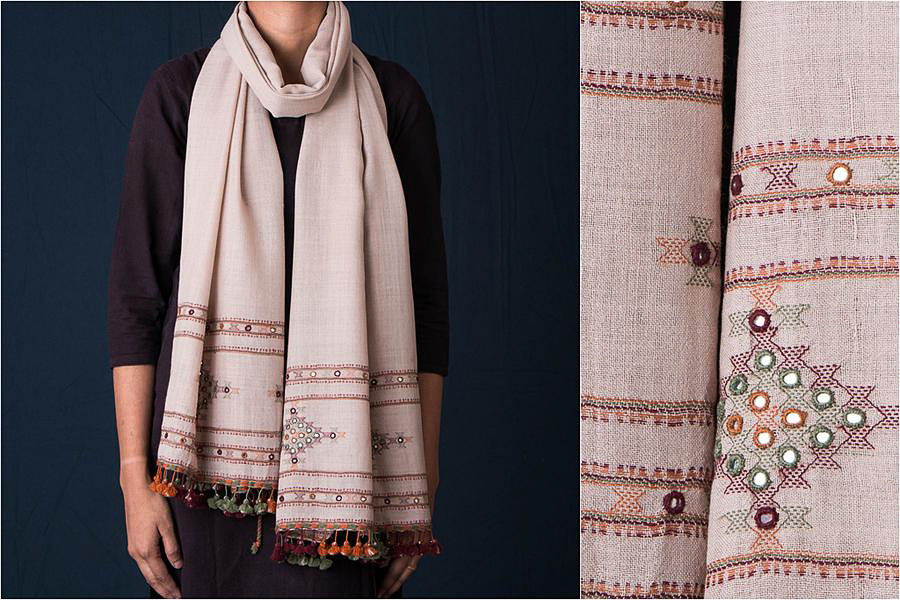
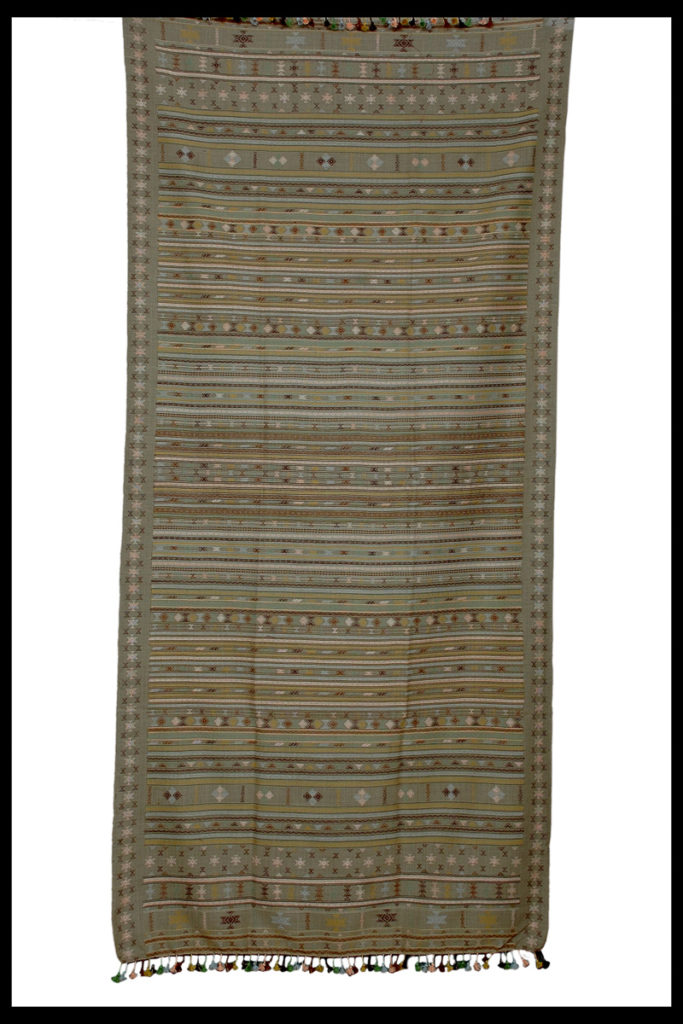
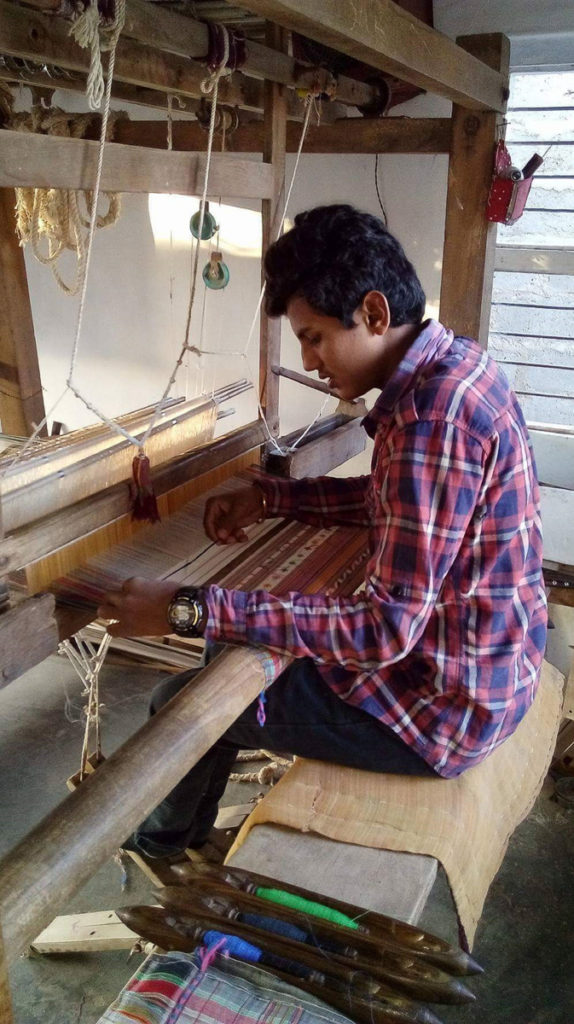

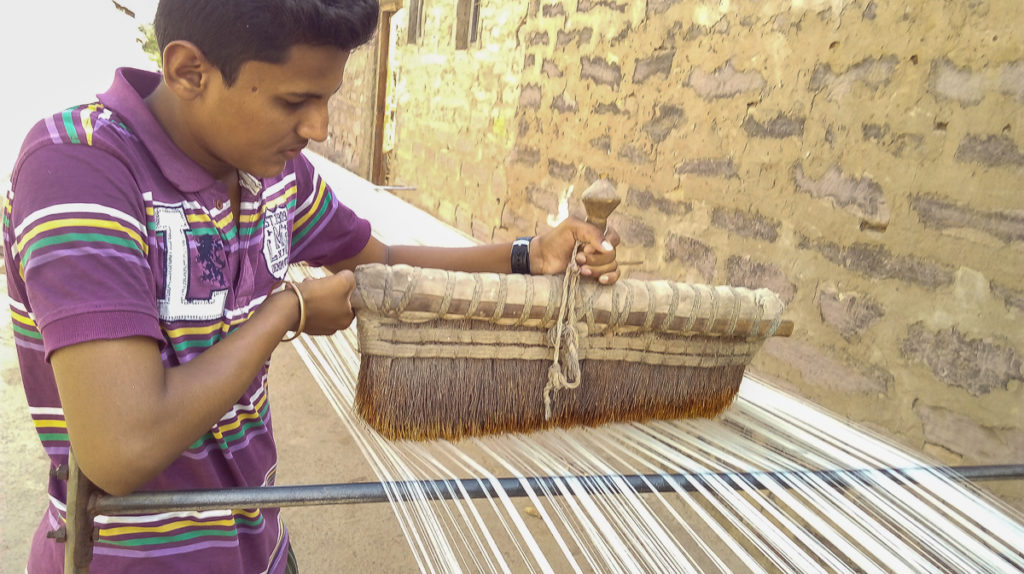
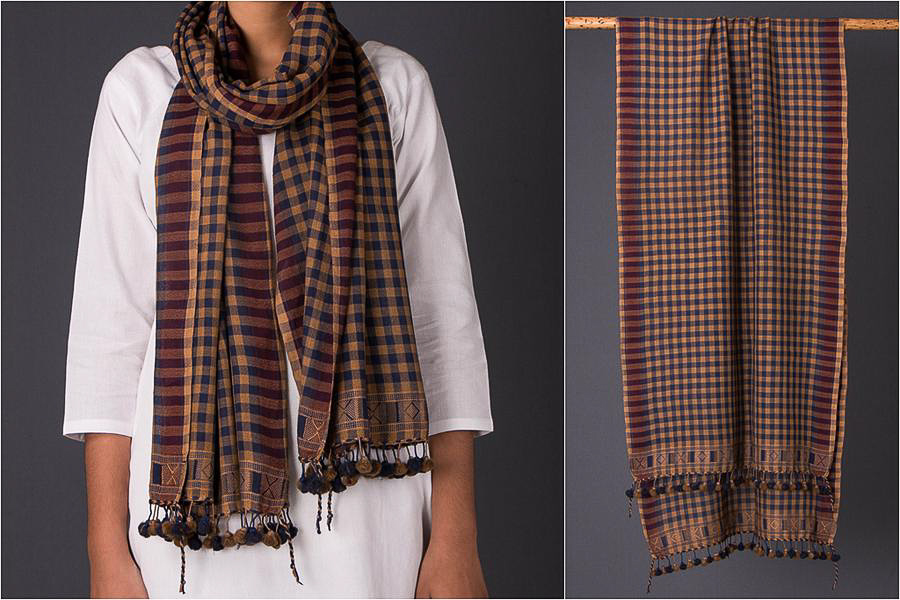

Comments
I am glad to reading this article, seeking your help to start a small business of handloom cloths.